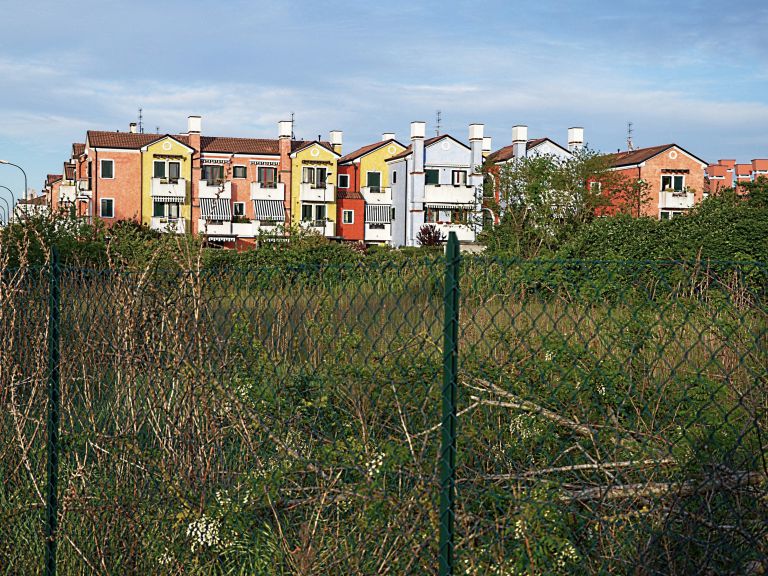Project Detail: The other Venice/ L'altra Venezia
Contest:
LuganoPhotoDays 2018
Brand:
LuganoPhotoDays
Author:
michela scarazzolo
Project Info
The other Venice/ L'altra Venezia
THE OTHER VENICE
Signals of ownership, of generation
in generation.
The first element and Serenissimi gardens,
primeval creatures, promises to keep,
new creatures.
Peripli 4.0 and levant echoes,
sea grooves and land furrows.
The chromatic circle closes.
"The lagoon is an ancient work of the lagoon [...]. In any case, Venice has no reason to worry: the slowness of sea erosion leaves time for thousands of years, and the inhabitants, wisely supporting the work of the canals, will certainly try to preserve their conquests. If only they kept their city cleaner [...] "
(Johann Wolfgang Goethe, Journey to Italy, 1816-1817, Italian edition 1983)
"I breathed in Venice only for people interposed (1913)"
"In Bangkok I found Venice: water or mainland?" (1925)
(Paul Morand, Venezie, 1971, Italian edition 1995)
"To look at it on paper, this city suggests two grilled fish served on the same plate, or perhaps the two claws of a lobster that almost overlap [...]; but it has neither a North nor a South, it has neither East nor West; it does not point you to a direction, always and only transverse ways ". (Iosif Brodskij, Fondamenta degli Incurabili, 1989, Italian edition 1991)
"The real reason is that going to Venice is a remission: it means abdicating utopia, renouncing adolescence. It is the place in Europe where the veracity of the highest note is ascertained that "the tourist is the one who, not being able to change the world, changes the world". Régis Debray, Against Venice, 1995 (published in 1996)
Venice, as we know, is always in the limelight. And almost always the media give us a city on the verge of collapse: whether it is the Unesco black list or the indecorous behavior of tourists, uncontrolled flows and (understandable) nuisance of the residents, scandals linked to the great works of safeguarding the city and its lagoon environment (MOSE). But the city is alive, even if the trace of this signal is weak because, as the "counter of the inhabitants" of the Morelli Farm in the San Bartolomio “field” reminds us, it is a number that is inexorably decreasing. Again, there are not only the inauguration of the Holy See Pavilion at the Architecture Biennale, and new shopping temples inside ancient warehouses (fondaci), exhibitions-event by contemporary artists revered by the market and not even the revisited Carnival. It is a city that marches along abused paths, which occupies spaces of the community, which cries to maintain essential social services and at the same time is a living contradiction, since the residents for generations migrate to the mainland, due to reckless building policies or disaffection, leaving room for new "adoptive Venetians", for a more or less long time, rarely in a definitive way.
That the lagoon was an integral part of the city, reflected the problems, styles, smells, the most authentic features, had already understood Goethe, at the end of '700. Morand has left us to imagine the limits of a city told and mediated by the looks of others, enlightening us still on the strength of this osmosis between land and water. Brodsky can not but feel strongly the link with the East, which in Venice means China but also the Muslim Levant, with which the Serenissima has for centuries maintained relationships of great fruitfulness, always on the verge of diplomatic conflict, when not military. And Venice has always been the most northern of the suq.
I think of Debray every time that Venice becomes the subject of angry controversy, of heavy accusations - like the photos that document the impact of the great ships in the San Marco Basin, immortalized by the genius of Gianni Berengo Gardin - but also distorted and involuntary by frantic and useless shots that will show, in the respective homelands of tourists, plastic images such as souvenirs on the stalls.
These twelve photos are the selection of a wider work of documentation, in a capillary manner, on the present and on the future in progress of this apparently unchanging "belt" that has protected the historic center for centuries, a vital link if Venice does not want to collapse under the weight of clichés and the impact of uncontrolled and neurotic tourism.
In the lagoon the water and the fruits of the peach coexist but also the land with its lush gardens. On the same shore, a gigantic jellyfish, which attracts and frightens children like a mythological being, dies not far from prodigious machines that promise to save Venice from its very waters and new skylines overlap with the artifact images of the postcards. The islands keep more tenaciously the traces of man's passages, they take care of it, proceed by accumulation. So, in Ca' Del Pra' (Lio Piccolo) there is no reason to get rid of the horses of old rides. The bright colors that characterize the houses of Burano are replicated, perhaps a bit 'wearily, in the terraced houses of Ca' Savio, not far from the camps for tourists. To weave a possible red thread among the photos, I have appealed to the voices of some, among many, authoritative writers and thinkers who have described, sung, idolized or criticized Venice, observers always attentive that teach us, also for the future, to look at the substance of the stone but also at the fragility of the boundaries of this "fish".
L'ALTRA VENEZIA
Segnali di proprietà, di generazione
in generazione.
Il primo Elemento e orti Serenissimi,
creature primordiali, promesse da mantenere,
nuove creature.
Peripli 4.0 ed echi levantini,
solchi di mare e solchi di terra.
Il cerchio cromatico si chiude.
“La laguna è opera antica della laguna […]. Ad ogni modo Venezia non ha motivo di preoccuparsi: la lentezza dell'erosione marina le lascia tempo per milleni, e gli abitanti, assecondando saggiamente il lavoro dei canali, si sforzeranno certo di conservare le loro conquiste. Se solo tenessero più pulita la loro città [...]”.
Johann Wolfgang Goethe, Viaggio in Italia, 1816-1817, edizione italiana 1983
“Respiravo Venezia solo per persone interposte”. (1913)
“A Bangkok ritrovavo Venezia: acqua o terraferma?”. (1925)
Paul Morand, Venezie, 1971, edizione italiana 1995
“A guardarla sulla carta, questa città fa pensare a due pesci alla griglia serviti nello stesso piatto, o magari alle due chele di un'aragosta che quasi si sovrappongono […]; ma non ha un Nord né un Sud, non ha Est né Ovest; non ti indica una direzione, sempre e solo vie traverse”.
Iosif Brodskij, Fondamenta degli Incurabili, 1989, edizione italiana 1991
“La vera ragione è che recarsi a Venezia è una remissione: vuol dire abdicare all'utopia, rinunciare all'adolescenza. È il luogo d'Europa in cui meglio si constata la veridicità della nota massima per cui “il turista è colui il quale, non potendo cambiare il mondo, cambia mondo”.
Régis Debray, Contro Venezia, 1995 (edizione italiana 1996)
Venezia, si sa, è sempre alla ribalta. E quasi sempre i media ci consegnano una città sull'orlo del tracollo: che si tratti della black list Unesco o dei comportamenti indecorosi dei turisti, di flussi incontrollati e (comprensibile) malanimo dei residenti, di scandali legati alle grandi opere di salvaguardia della città e del suo ambiente lagunare (MOSE). Ma la città è viva, anche se la traccia di questo segnale è debole perché, come ci ricorda il “contatore degli abitanti” della Farmacia Morelli in campo San Bartolomio, è un numero che sta inesorabilmente calando. Di nuovo, non ci sono solo l'inaugurazione del padiglione della Santa Sede alla Biennale Architettura, e nuovi templi dello shopping dentro fondaci (magazzini) antichi, mostre-spettacolo di artisti contemporanei venerati dal mercato e nemmeno il Carnevale rivisitato. È una città che marcia lungo percorsi abusati, che occupa spazi della collettività, che grida per mantenere servizi sociali essenziali e al tempo stesso è una contraddizione vivente, poiché i residenti da generazioni emigrano in terraferma, a causa di politiche edilizie sconsiderate o per disaffezione, lasciando spazio a nuovi “veneziani d'adozione”, per un tempo più o meno lungo, raramente in via definitiva.
Che la laguna fosse parte integrante della città, ne riflettesse le problematiche, gli stilemi, gli odori, le peculiarità più autentiche, l'aveva compreso già Goethe, a fine '700. Morand ci ha lasciato immaginare i limiti di una città raccontata e mediata dagli sguardi altrui, illuminandoci ancora sulla forza di questa osmosi tra terra e acqua. Brodsky non può che sentire con forza il legame con l'Oriente, che a Venezia significa Cina ma anche il Levante musulmano, con la quale la Serenissima ha intrattenuto per secoli rapporti di grande fecondità, sempre al limite dello scontro diplomatico, quando non militare. E Venezia è da sempre il più a Nord dei suq.
Penso a Debray ogni volta che Venezia diventa oggetto di polemiche rabbiose, di j'accuse pesanti - come le foto che documentano l'impatto delle grandi navi nel Bacino di San Marco, immortalate dal genio di Gianni Berengo Gardin - ma anche distorta e involgarita da scatti forsennati e inutili che riporteranno, nelle rispettive patrie dei turisti, immagini di plastica come i souvenirs sulle bancarelle.
Queste dodici foto sono la selezione di un lavoro più ampio di documentazione, in maniera capillare, sul presente e sul futuro in divenire di questa “cintura”, apparentemente immutabile, che ha protetto per secoli il centro storico, legame vitale se Venezia non vuole collassare sotto il peso dei luoghi comuni e dell'impatto di un turismo incontrollato e nevrotico.
Nella laguna convivono l'acqua e i frutti della pesca ma anche la terra con i suoi orti rigogliosi. Sulla stessa riva, una medusa gigantesca, che attrae e spaventa i bambini come un essere mitologico, muore non lontano da macchine prodigiose che promettono di salvare Venezia dalle sue stesse acque e nuovi skylines si sovrappongono alle immagini artefatte delle cartoline.
Le isole conservano più tenacemente le tracce dei passaggi dell'uomo, ne hanno cura, procedono per accumulo. Così, a Ca' Del Pra' (Lio Piccolo) non c'è motivo di liberarsi dei cavallucci di vecchie giostre.
I colori vivaci che contraddistinguono le case di Burano vengono replicati, forse un po' stancamente, nelle villette a schiera di Ca' Savio, non lontano dai campeggi per i turisti.
Per tessere un possibile filo rosso tra le foto, mi sono appellata alle voci di alcuni, tra i tanti, scrittori e pensatori autorevoli che hanno descritto, cantato, idolatrato o criticato Venezia, osservatori sempre attenti che ci insegnano, anche per il futuro, a guardare alla sostanza della pietra ma anche alla fragilità dei confini di questo “pesce”.
Venezia, 25 maggio 2018


















